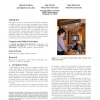Free Online Productivity Tools
i2Speak
i2Symbol
i2OCR
iTex2Img
iWeb2Print
iWeb2Shot
i2Type
iPdf2Split
iPdf2Merge
i2Bopomofo
i2Arabic
i2Style
i2Image
i2PDF
iLatex2Rtf
Sci2ools
HRI
2006
ACM
2006
ACM
Interactions with a moody robot
This paper reports on the results of a long-term experiment in which a social robot’s facial expressions were changed to reflect different moods. While the facial changes in each condition were not extremely different, they still altered how people interacted with the robot. On days when many visitors were present, average interactions with the robot were longer when the robot displayed either a “happy” or a “sad” expression instead of a neutral face, but the opposite was true for low-visitor days. The implications of these findings for human-robot social interaction are discussed. Categories and Subject Descriptors J.4 [Social and Behavioral Sciences]: psychology; I.2.9
Facial Changes | HRI 2006 | Human Robot Interaction | Human-robot Social Interaction | Robot’s Facial Expressions |
| Added | 13 Jun 2010 |
| Updated | 13 Jun 2010 |
| Type | Conference |
| Year | 2006 |
| Where | HRI |
| Authors | Rachel Gockley, Jodi Forlizzi, Reid G. Simmons |
Comments (0)

